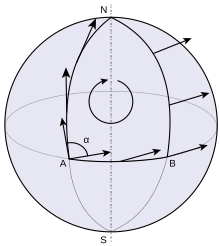Holonomy
The mathematical term of the holonomy group of a connection of a vector or main fiber bundle over a differentiable manifold (abbreviated also simply holonomy ) describes the group of linear transformations in differential geometry that is induced by the parallel transport of vectors along closed curves. Carries a manifold a Riemannian metric , then their is Riemannian Holonomy by the Holonomy of the Levi-Civita connection on the tangent bundle of given.
Examples
As an example, consider the spherical surface with the standard metric from the . We fix a point on the spherical surface, something like in the adjacent drawing. An element of the tangential space is then a vector lying tangentially on the spherical surface and originating in . As indicated in the adjacent drawing, we consider the parallel transport of this vector along the closed path . It becomes clear that the displaced vector in the point was rotated by a certain angle in comparison to the starting vector , and it is clear that every other vector is rotated by the same angle by this parallel transport, i.e. That is, the rotation through this angle in space is an element of the holonomy group in the point . It is also clear that by using other closed paths on the surface of the sphere, any angle of rotation can be obtained. The holonomy group is isomorphic to the group of rotations in two-dimensional space. Since the spherical surface is path-connected , an isomorphic holonomy group is obtained at every point. Namely another point and a path from after , we obtain from a parallel transport at the point such at the point , by a tangent to initially longitudinally parallel to shifts, where the given parallel transport at point applies and the result along the reverse path back back to moves. This obviously defines an isomorphism between the holonomy groups an and .
If one looks at Euclidean space with the Euclidean metric, i.e. the standard scalar product, as a further example , the concept of parallelism coincides with geometric parallelism. Any kind of parallel displacement of a vector does not change its direction. So if you move in parallel along a closed path, you get back the starting vector, that is, a parallel transport at a given point is always the identical mapping . Hence, the holonomy group is trivial in this case .
Importance in physics
Holonomy groups play a major role in theoretical physics, both in quantum field theory (see Wilson Loop ) and, in particular, in string theory . The holonomy group of compact six- and seven-dimensional manifolds is of interest here, since when the theory is compacted on these spaces, the number of supersymmetry obtained depends on the maximum number of covariant constant spinors , which in turn is determined by the holonomy. Manifolds of particular interest are six-dimensional Calabi-Yau manifolds with SU (3) holonomy and seven-dimensional manifolds with G2 holonomy.
Web links
- Eric W. Weisstein : Holonomy Group . In: MathWorld (English).













